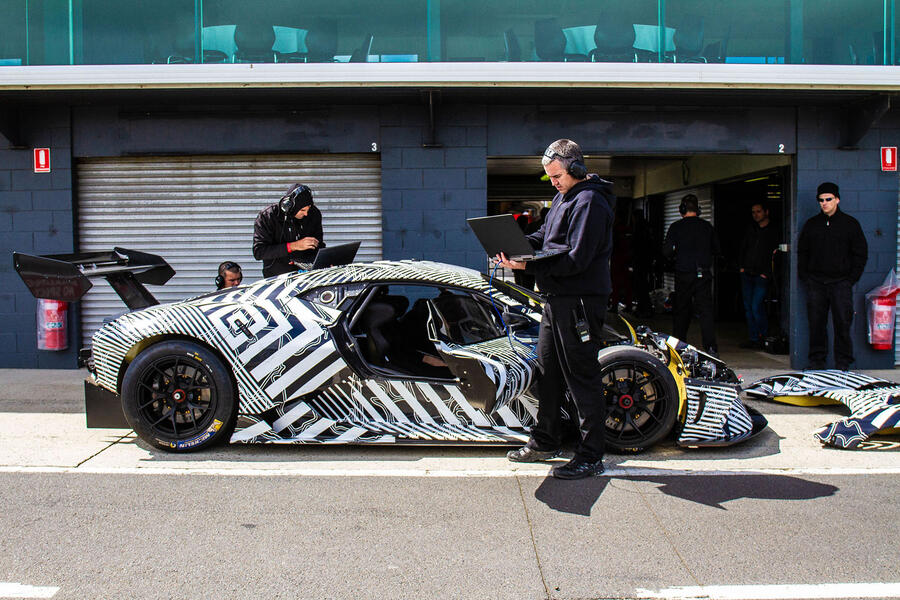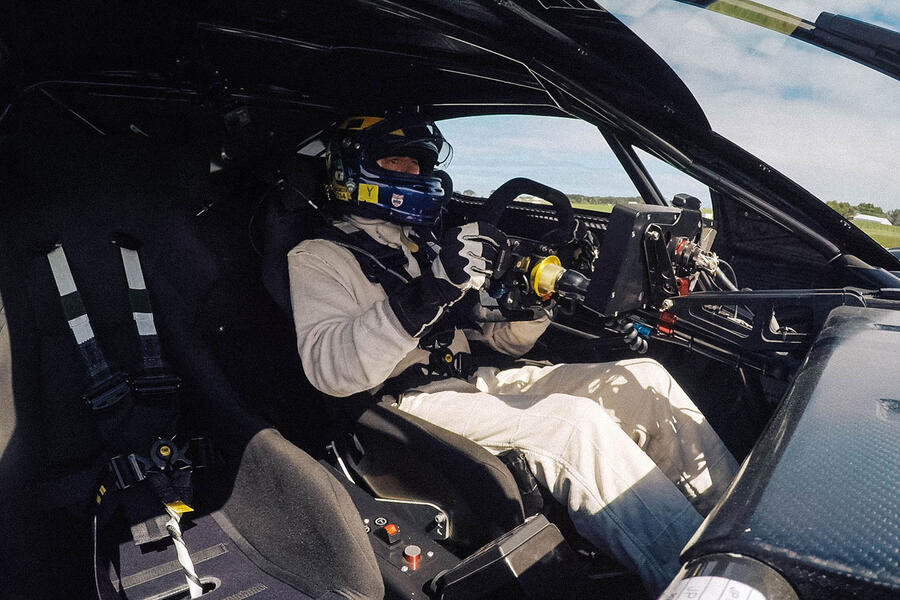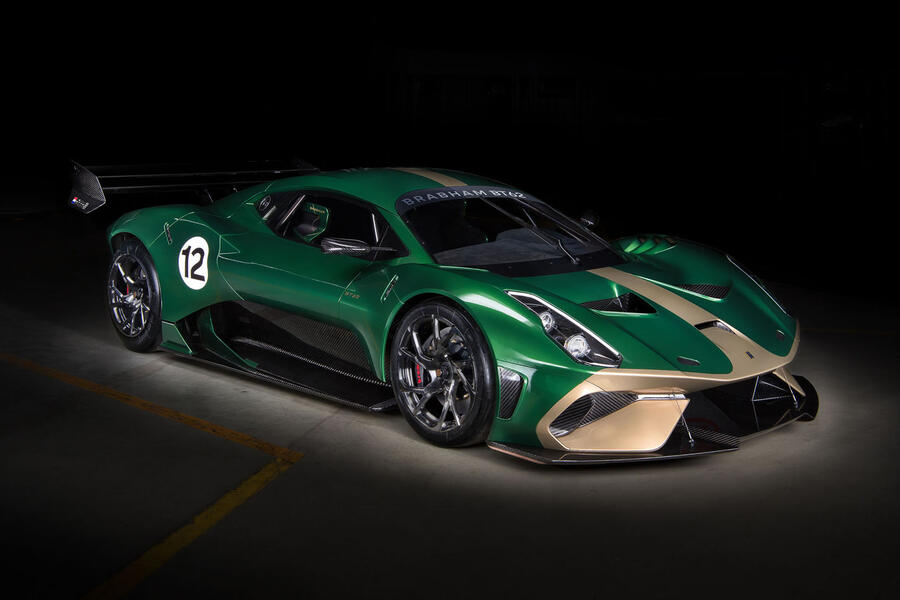The new Brabham BT62, a McLaren Senna-rivalling 700bhp track-only hypercar, has been launched at Australia House in London, with its maker claiming the car will “reward like no other”.
Priced at £1 million before taxes and options, the BT62 is the first car from Brabham Automotive, which is run by former Formula 1 racer and Le Mans 24 Hours winner David Brabham, the son of triple world champion Sir Jack. The company claims it has a long-term phased product development plan and will manufacture “high-performance vehicles which challenge and reward the driver in equal measures”, with an “ultimate goal” to compete in Le Mans 24 Hours.
Opinion: can Brabham Automotive emulate McLaren?
The limited-run BT62 is a track-only, rear-wheel-drive two-seater powered by a 5.4-litre naturally aspirated mid-mounted V8 quad-cam engine that produces 492lb ft of torque. The car features carbonfibre body panels and weighs 972kg, giving a power-to-weight ratio of 720bhp per tonne.
By comparison, the £750,000 McLaren Senna features a 789bhp 4.0-litre twin-turbo engine and has a dry weight of 1283kg, with a power-to-weight ratio of 660bhp per tonne.

McLaren Senna: first drive in 789bhp track-only hypercar
Brabham Automotive says the BT62 has been “specifically designed, developed and tested to reward like no other”. The car’s name comes from the convention established by Sir Jack Brabham’s team – officially known as Motor Racing Developments, which won four F1 drivers’ and two makes’ championships during its 30-year history.
David Brabham said the BT62 started “the next chapter in the evolving Brabham story” and that it is “a car truly worthy of carrying the iconic Brabham name”.
The BT62 is 4460mm long and 1950mm wide, with a wheelbase of 2695mm. It features substantial aerodynamics including an adjustable rear wing, which the firm claims produces more than 1200kg of downforce, and has a 41/59 front-to-rear weight distribution. The power is delivered through a six-speed Holinger sequential gearbox, with steering wheel-mounted paddles.
The car has 18in wheels front and rear, with Michelin competition tyres and six-piston carbon-on-carbon Brembo brakes. In keeping with its motorsport heritage, the BT62 features a six-point racing harness, removable carbonfibre steering wheel, a 125-litre fuel tank with quick-fill connectors and a built-in air jack system.
The car will be sold in left-hand drive as standard, with right-hand drive available “on request”. Owners will become members of a Brabham driver development programme designed to develop their “physical ability and determination” to the point where they can “fully exploit” the BT62’s performance.

Autocar’s top 10 supercars of 2018
Paul Birch, who headed development of the car, said the BT62 was created from a blank sheet of paper over a two-year engineering and development programme. He added: “It’s a car that demands total engagement and commitment from its driver, delivering immense reward and satisfaction.”
Steve Cropley: why Sir Jack Brabham was a motorsport hero (from 2014)
The BT62 will be limited to 70 cars to mark, according to the team, the 70 years since Jack Brabham began racing in Australia. The Anglo-Australian company will have offices in the UK and Adelaide, South Australia, where the BT62 will also be built at a 15,000 square-metre facility.
The first 35 cars will be liveried to reflect each of the grand prix team’s 35 world championship race wins. The first car, on display at the launch event, was finished in the green and gold colours carried by the BT19, which Brabham used to take his team’s first victory in the 1966 French Grand Prix at Reims.
The launch event at Australia House, the home of the Australian High Commission in London, featured a display of Brabham racing cars and memorabilia. The exhibition will now be opened to the public (by ticket only).

Brabham’s racing heritage
Having won back-to-back F1 titles in 1959 and 1960 for Cooper, Jack Brabham founded his eponymous team – officially known as Motor Racing Developments Ltd – with engineer Ron Tauranac in 1962. The firm quickly built a business selling customer chassis – all carrying the BT nomenclature to recognise the two founders – for use in various single-seat categories, whileBrabham and team-mate Denny Hulme claimed back-to-back F1 titles for the outfit in 1966 and 1967.
Brabham retired after the 1970 season, selling his share of the team to Tauranac, who sold it to Bernie Ecclestone the following year. The squad experienced a resurgence in the 1980s, in part thanks to star designer Gordon Murray, with Nelson Piquet winning drivers’ titles in 1981 and 1983.
The team’s fortunes faded when Murray left for McLaren at the end of 1986, while Ecclestone’s attention was increasingly focused on his role with the Formula One Constructors’ Association. Ecclestone sold the squad in 1988. It changed hands several times after that, eventually folding after the 1992 season, when owner Middlebridge Group Ltd hit financial trouble.
A German businessman attempted to revive the Brabham name and enter F1 in 2010, sparking a legal battle with the Brabham family, who were eventually granted use of the name. In 2014, David Brabham launched a Project Brabham scheme to crowdsource a sports car race team to compete at Le Mans.
Read more
Opinion: can Brabham Automotive emulate McLaren?
McLaren Senna: first drive in 789bhp track-only hypercar
Steve Cropley: why Sir Jack Brabham was a motorsport hero (from 2014)